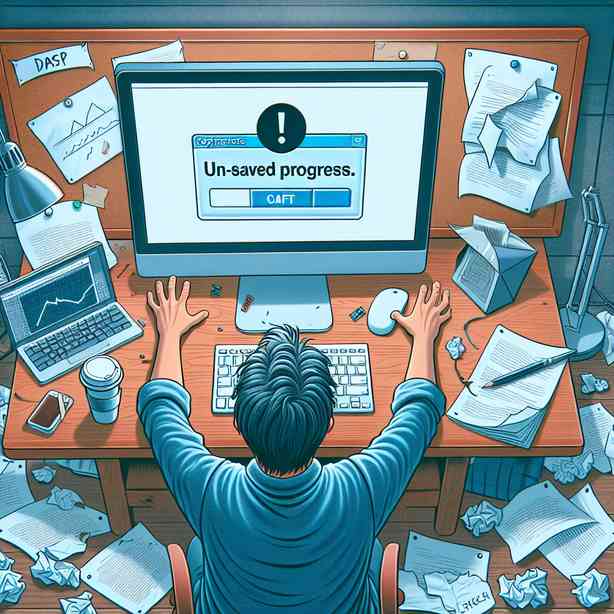
The experience of forgetting to save your work can be frustrating, yet it is one that many of us have encountered at some point in our lives. This scenario often unfolds in a variety of settings, from school assignments to professional presentations. In this article, we will delve into the emotional and practical ramifications of this seemingly minor oversight, as well as preventative strategies to avoid such pitfalls in the future.
Imagine you’ve been working tirelessly on an important document or project, possibly for hours on end. You meticulously organized your thoughts, conducted thorough research, and even crafted a polished conclusion. As you lean back in your chair, satisfied with your effort, disaster strikes: you realize that none of your hard work has been saved. It’s a sinking feeling, one that brings with it a range of emotions from frustration to anxiety. The digital age provides us with powerful tools, yet it also comes with vulnerabilities, and the act of forgetting to save can feel like an unexpected punch to the gut.
The immediate reaction often involves disbelief. You may find yourself frantically checking your application, hoping against hope that there is an auto-save feature you can rely on. Some applications include such features, but they are not foolproof. Many of us have fallen victim to the temptation to neglect saving during our workflow, assuming that the system will protect us from any fallout. This is where awareness becomes crucial; understanding the limitations of technology can serve as a wake-up call.
Emotionally, the implications of not saving your work can be significant. This experience can lead to feelings of inadequacy, especially if your work was for an important presentation or deadline. You might question your ability or commitment, which can inadvertently affect your future productivity. The pressure of rapidly having to redo work can create a cycle of stress, further complicating the creative process. It’s essential to recognize these emotional reactions and understand that they are normal, yet should not dictate how you approach similar tasks in the future.
Importantly, this situation can serve as a valuable lesson. Once you’ve processed the initial shock and frustration, consider it a moment of learning. Reflect on what led to the oversight: Were you distracted? Were you in a rush to meet a deadline? Each experience can teach us not just about the importance of saving but about managing our workflow and focus.
In light of these lessons, it becomes crucial to implement strategies that prevent this scenario from occurring in the future. One simple method is to develop a habit of saving your work consistently. Setting a timer that prompts you to save every few minutes can ensure that you capture your progress.
In addition to manual saving, explore the various options your software offers. Many programs allow for auto-save intervals to be adjusted based on your desired frequency. If you are unsure how to configure these settings, take a moment to look through the help resources available. It may seem trivial, but small adjustments in your approach to saving can have large implications for your overall workflow.
Moreover, consider backing up your work in multiple formats or locations. Cloud storage options, external hard drives, or USB drives provide redundancy, allowing you to access your work from different devices or restore it if something goes wrong. There are also services that automatically back up your work at regular intervals, helping to mitigate the risk of data loss.
We often underestimate the significance of digital organization and best practices. Developing a routine that integrates these safety nets can elevate the quality of your work while simultaneously providing peace of mind. Keep your workspace organized and allocate specific times to review what you’ve accomplished, as it helps you stay aware of what needs saving.
Another aspect to consider is digital literacy. The ability to proficiently navigate technology is a skill that can be improved upon. Familiarizing yourself with the software you use frequently reduces the likelihood of mishaps. Take the time to explore features and functionalities; what may seem like a minor detail can make a significant difference in your efficiency and productivity.
While the aftermath of forgetting to save your work can be disheartening, it also offers opportunities for growth. Each time we face a setback, we can choose to view it as a stepping stone, instead of an obstacle. Practice self-compassion; everyone makes mistakes, and it is essential not to be too hard on yourself. Embrace the experience, reflect on it, and move forward with a renewed commitment to better practices.
As we navigate the complexities of our digital and professional lives, let us remember that technology is a tool meant to assist us, but it requires our active participation to be effective. Developing mindful habits around saving work not only protects your efforts but enhances your workflow. In the long run, these practices are more than about saving files; they are about fostering a disciplined approach to your tasks.
In conclusion, forgetting to save your work can serve as an important learning moment. While it may initially lead to frustration or discouragement, viewing it as an opportunity for growth can reshape your perspective. By adopting better saving practices, improving your digital literacy, and reflecting on your workflow, you can ensure that your hard work is safeguarded for future endeavors. The next time you feel enamored with a project, remember to hit that save button—it could be the key to preserving your creativity and efforts for days to come.


